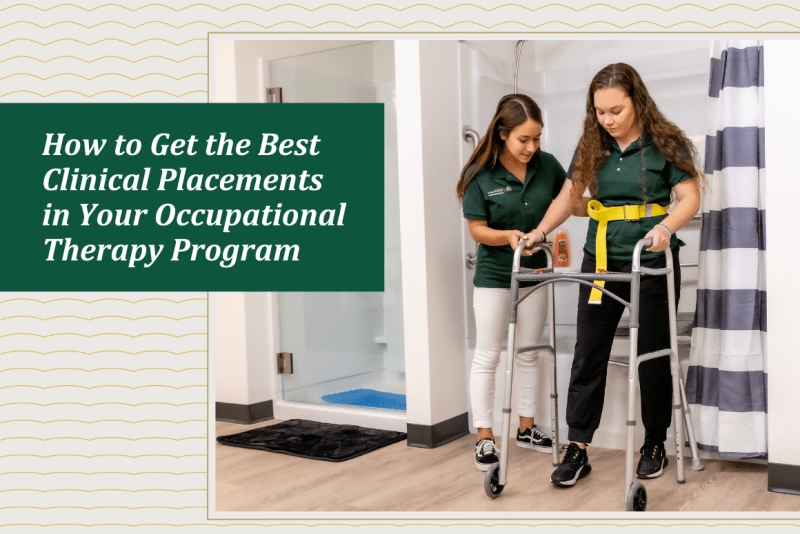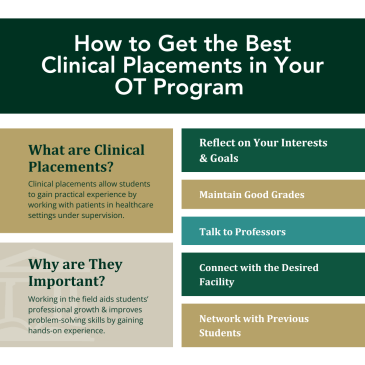
Helping others is a crucial part of working in healthcare settings. Working in occupational therapy directly empowers clients to recover, improve, or maintain their skills that enrich their quality of life. But how do you make sure you do everything you can to meet this career goal? It all starts with clinical placements — and everything you do leading up to them to make sure you have the best opportunities to kickstart your journey as an aspiring occupational therapist.
What is Occupational Therapy?
Occupational therapy is a healthcare profession that evaluates or treats patients with injuries, illnesses, or disabilities. Occupational therapists can work in a variety of settings, such as schools, rehabilitation services, gyms, hospitals, and clinics. They work to help patients improve their quality of life by helping them develop important skills for their daily lives and meeting their personal goals. Occupational therapists may also assess a client’s living conditions and prescribe equipment (such as crutches or wheelchair ramp installations) to assist them with these everyday tasks.
Distinct from physical therapy, which focuses on improving a patient’s ability to move, occupational therapy often works to improve sensory processing and motor skills that can be needed for everyday living. Another unique factor of occupational therapists is that they work closely and personally with their patients, often in environments comfortable and familiar to them. Client-centered care is at the forefront of the job description. From treatment planning to personalized meetings, occupational therapy aims to make meeting your goals personal.
______
Who are you called to be?
Pursue your purpose at PLNU.
______
What are Clinical Placements and Why Are They Important?
Clinical placements are when OT students work under a supervisor or trainer in a healthcare setting to work hands-on with patients for the first time. During clinical placements, students further develop the knowledge they’ve learned in their programs and apply it to their real-life field experience. This required component of an occupational degree program aims to encourage students to apply their learned skills in various healthcare settings to gain experience in their desired field.
For aspiring occupational therapists, clinical placements are also called fieldwork rotations, clinical rotations, or clinical experiences but they all work to meet the same goal — to simulate the day-to-day work life of a real occupational therapist in these healthcare settings. One of the most important aspects of healthcare education is getting hands-on learning experience in the field. Working in the field encourages students in their professional development, allowing them to encounter challenges and learn to problem-solve. Clinical placements are essential for every student in health sciences.
When starting off, OT students can expect to be placed in Level I fieldwork. This first sector of placements is mostly observational, with students typically shadowing their assigned healthcare professionals during their occupational therapy clinical. Through this, aspiring professionals can see what they can expect from this career through current professionals.
After graduating to Level II fieldwork, students can expect more hands-on fieldwork experience. Typical responsibilities from students include working directly with patients, billing services, and documentation. Students who undergo Level II fieldwork usually only focus on their clinical placement and take no other classes. For PLNU’s M.S. in Occupational Therapy, students are expected to complete 24 weeks of Level II fieldwork within the 18-month period of completing the didactic portion of the program. After fieldwork requirements are completed, students prepare to complete the National Certification of OT Exam before obtaining their license.
The curriculum for these clinical placements can also vary from institution to institution. Students at PLNU would be expected to complete two different clinical experience categories that directly impact underserved populations.
How to Get the Best Clinical Placements
1. Reflect on your interests and goals
Knowing where you want to be down the road can be beneficial for any student. Targeting specific facilities and clinics that specialize in what you want to do will lead to your best chances at zeroing in on the career experience you want to explore. When doing this, it’s also important to start researching clinical placements early since preceptor approval can sometimes take longer than expected.
2. Maintain good grades
Maintaining your grades shows preceptors how seriously you take not only your academics but also your future career. In addition, crafting your resume to the best of your ability can increase your chances of landing the clinical placement you want. Contacting Career Services can help you build a resume that highlights your specific experiences and skill set that is sure to impress potential recruiters.
3. Talk to professors
Supervision and mentorship are key for establishing long-lasting relationships within the healthcare field. Your professors in your OT program can be an outlet for obtaining your preferred clinical placement. Not only could they be the key for a referral letter but they can also offer valuable insight into their experience and any information about clinical sites. Using school resources can help direct you toward your desired placement.
4. Connect with the desired facility
Another valuable tool in obtaining the best clinical placements is reaching out directly to potential facilities. Reaching out to connect with these facilities not only allows you to learn more about your potential workplace but also establishes familiarity with the staff and builds a connection with them.
5. Network with previous students
One of the best resources to have is knowing someone in your field. Networking with previous students who had great fieldwork experience can be beneficial because they are able to share and offer advice to incoming students. Their past preceptors may also accept future referrals for their clinical sites. One clinical director noted that most students find their preceptor from previous academic or workplace relationships showing that networking is a valuable asset when researching the best fit for you.

Occupational Therapist Job Outlook
Average Salary: $96,370
It’s no surprise that opportunities and demand for occupational therapists are growing. By 2030, the need for occupational therapists will grow to 12% (much faster compared to other healthcare occupations).
As an occupational therapist, you have a tangible impact on clients’ lives. Knowing you’re making a difference in helping clients maintain their activity and independence through therapeutic interventions can help you feel fulfilled and excited about your career. Being an occupational therapist also requires creativity. Occupational therapy requires professionals to think outside the box when finding individualized solutions for each client, and treatment planning will need to be modified for each person and needs to work according to their environment.
Whether you’re assessing in-home activities to help a client achieve their everyday tasks or working with them in a rehabilitation center to improve muscle function, occupational therapists focus on helping their clients achieve their goals for any and every aspect of their well-being and functionality.
Begin your Journey to become an OT at PLNU
Clinical placements can feel unpredictable at first but being prepared will ensure your best chances for achieving your personal goals. PLNU’s M.S. in Occupational Therapy can help your journey to achieving these goals through quality academics, resources, hands-on training, interdisciplinary teamwork, and five clinical experience opportunities throughout the program. Becoming who you are called to be means being equipped with the necessary tools to succeed. While pursuing your occupational therapy degree, PLNU works to make sure you have the resources and support system you need to begin taking on the role of changing lives for the better.